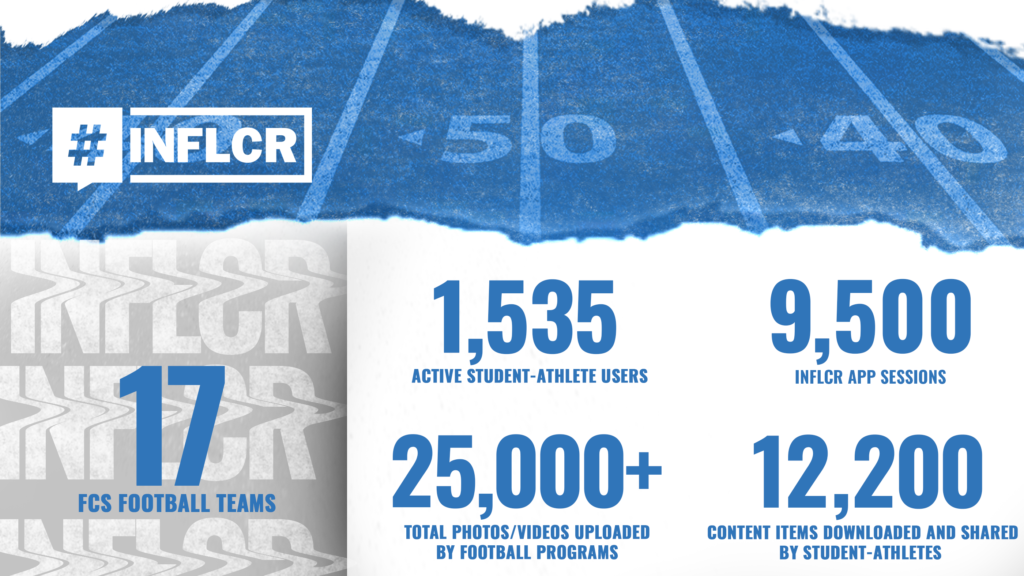Student-athlete brand-building moves to forefront during unprecedented spring 2021 football season
A global pandemic and scheduling chaos have created a unique opportunity in the spotlight for those Football Championship Subdivision teams that are taking the field this spring.
With the 2021 playoffs underway, many of the top programs in the FCS are utilizing technology to maximize the exposure, while also empowering their student-athletes to tell their stories and build their personal brands.
Central to that approach is INFLCR, a software that helps sports teams and leagues manage and distribute digital content to their network of brand ambassadors. Student-athletes, coaches, staff and other brand ambassadors receive photos, videos and graphics produced by their universities and delivered to their mobile devices through the INFLCR mobile app, which they can share editorially to their personal social media channels.

This process is made seamless through the power of INFLCR’s artificial-intelligence technology that recognizes faces, jersey numbers and file metadata to tag the content and sort into personalized galleries, which are accessed via the app.
“Delivering content to athletes is a priority at Monmouth because they are our best and most efficient brand ambassadors for the University and athletics department,” said Greg Viscomi, Monmouth’s Associate Athletic Director for New Media & Communications.
“On a daily basis their social media reach is ten-fold what our official channels reach.”
Monmouth is one of seven playoff teams that have utilized INFLCR this spring. INFLCR examined the usage of 17 FCS football programs, finding that a combined 1,535 student-athletes logged almost 9,500 sessions in the app to view content in March. Their teams uploaded a cumulative total of more than 25,000 content items, of which more than 12,200 were downloaded/shared.
In the national rankings rankings of April 11, No. 1 James Madison, No. 2 North Dakota State and No. 3 Weber State were among eight programs ranked in the top 12 that were using INFLCR to distribute content this spring.
It starts off with usage: Student-athletes practically live inside their INFLCR app to access their personalized content.
At No. 3 national seed James Madison, 102 football players are active in the app, logging more than 1,600 sessions to view content in March. JMU football players averaged one session PER DAY in March.
The usage mirrors the department-wide usage at JMU, which has been an INFLCR partner since 2019.
This type of usage isn’t unique to James Madison.
— At Ohio Valley Conference champion Jacksonville State, the No. 4 overall national seed, the communications staff uploaded more than 4,800 content items in March with student-athletes downloading/sharing more than 2,400 in 729 sessions in the app.
— Defending national champion North Dakota State launched a trial of INFLCR by downloading/sharing 207 of the first 858 items uploaded by staff.
— At Big Sky champion Weber State, 79 active players downloaded/shared a combined 953 content items from the more than 2,100 files uploaded by staff.
— At Colonial Athletic Associate champion Delaware, ranked No. 7, staff uploaded more than 2,800 content items, with athletes downloading/sharing more than 1,500 in March while logging 760 sessions in the app.
— At No. 10 Villanova, student-athletes on a trial downloaded/shared 591 of 1,564 content items uploaded by staff.
— At No. 16-ranked Kennesaw State, 127 student-athletes logged 563 app sessions in March to downloads/share 776 of 1,237 items uploaded by staff.
At No. 22 Austin Peay, 101 student-athletes downloaded/shared 1,584 of 3,285 content items.
Warren May, the director of football social media at Austin Peay, said his department has been strategic in attempting to maximize the exposure provided by a spring season. With fan attendance limited by the pandemic, social media has taken on an even more vital role.
“I wanted to get out as much content as possible,” May said. “I didn’t want to choose a few players and take pictures of them. My main goal is to get everybody involved as much as possible. That keeps morale up for everyone in our program.
“Everybody wants something to post. Whether its photos from practice, games or a promotional shoot, I have been able to get just about everyone on the team features in at least one photo.”
Partner Highlight: Monmouth University
One of the biggest success stories in FCS has been Big South champion Monmouth University, which this spring has carried over the momentum and efficiency of a record-breaking 2019 season that saw the program’s content-delivery and usage for football rival the productivity of Power 5 departments. That success resulted in the program expanding its INFLCR partnership department-wide.
Monmouth Football has uploaded more than 1,300 content items this spring. Of those, a staggering 981 have been downloaded/shared. The usage is team wide, with 119 student-athletes active on the app, logging almost 2,000 sessions to view and share content this spring.
Like all INFLCR partners, Monmouth Athletics can measure the impact those editorial shares have both for the team and athletes’ personal brands.
Brand-building has become a focus in recruiting at Monmouth, especially with NCAA pending that will create opportunities for student-athletes to make money using their Name, Image and Likeness.
“It’s huge {in recruiting},” Monmihth’s Viscomi said. “That’s how we were able to convince our department administrators and coaches to agree to the cost of INFLCR. No one can reach potential recruits in such a way that our current athletes can.
“These recruits follow our players, potential transfers follow our players and coaches, more content shows these recruits that we are serious about building their personal brand.”
Austin Peay’s May said providing student-athletes with the opportunity to tell the story of their experience at Austin Peay has become a centerpiece of the team branding efforts, especially in recruiting where prospects are paying attention to current players. An INFLCR analysis of 20,000+ student-athletes’ social audience found that 26 percent of the athletes’ following consists of potential student-athlete recruits.
“INFLCR has helped me market the players, the coaches and the brand of Austin Peay,” May said. “We were able to verify several accounts, and get our guys actively inquiring about when more content is going to be uploaded.
“It gives us a chance to show off our uniforms, our facilities, and the personalities of our players and our coaching staff. When recruits see how we promote our players, they want to be a part of that because exposure is what they’ll need to get noticed by the professionals.”
As part of the agreement, Monmouth also gained royalty-free access to INFLCR’s content-partnership with Atlantic Records, giving MU Athletics the rights to use editorial content from the playlist of top hits in highlight videos across approved social-media accounts.
“The Atlantic Records deal is one of the main reasons we elected to sign a long-term contract with INFCLR,” Viscomi said. “We’ve used it to enhance our best and most important content.
“In the past players would ask why we didn’t use popular music in our highlight packages and other videos and we had to explain to them about royalties. Using the Atlantic artists have brought our video content to another level, it has really enhanced it greatly.”
Content Delivery Process for Football Programs
Teams are producing large amounts of content, and players (as seen from the large number of app sessions and shares) are hungry to access it. However, before INFLCR, delivery was time consuming for a time-strapped staff. INFLCR makes that easy at a time when department staffs are now juggling overlapping sports seasons made further busy by the impact of the pandemic.
The secret sauce here is that INFLCR makes content easy to distribute and easy to access by putting personalized content at the student-athletes’ fingertips. As they share it, they expand the program’s reach to key segments of fans and recruits while also growing their own following.
May said that at a time when communications/creative staff are especially spread thin due to overlapping competition schedules created by the pandemic, the ability to deliver massive amounts of content to scale has been an invaluable efficiency.
“Uploading the content on INFLCR was quick and easy,” May said. “I would use Teamworks to let them know when there is an upload. From there, they all attack the gallery right away. The AI tagging features has helped tremendously as well.
Monmouth’s Viscomi agreed.
“Before (INFLCR) we used to have coaches, other staff members and players texting, emailing and stopping by the office to get their photos. Sometimes we would give them a few, sometimes we would make them wait until the end of the year to get them all,” Viscomi said. “Delivery was an issue, they never had hard drives, they had to sit there and literally batch email themselves.
“Looking back it was a total nightmare. Now, after our photos are edited and named, they get uploaded and most of them are auto-tagged and the players and coaches have their content.”
How It Works
INFLCR, the leading software company powering student-athlete brand-building, provides college athletic departments with the platform and mobile app that ensure student-athletes are provided the content, analytics, and more to grow their social media followings and participate in upcoming opportunities from NIL legislation.
Equipped with those tools, student-athletes in any participating sports are able to access the content provided by the university’s communications, digital, video and graphics staff, delivered through INFLCR, to effectively communicate their story on their personal social media accounts.
After the fact, the student-athletes and the university are able to measure the increased audience engagement coming from the much-larger collective audience of those athletes, and can also assess the impact of posting more content on the growth of student-athlete accounts.
Programs are using this approach to bolster their online presence in a way that impacts community engagement, recruiting, fundraising, and ultimately provides best-case scenarios for student-athletes who will soon look to participate in commercial activities from NIL.

 Previous Story
Previous Story




